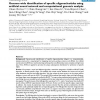1211 search results - page 172 / 243 » Predicting building contamination using machine learning |
BMCBI
2004
14 years 9 months ago
2004
Background: In addition to known protein-coding genes, large amounts of apparently non-coding sequence are conserved between the human and mouse genomes. It seems reasonable to as...
IJCV
2008
14 years 9 months ago
2008
Object identification (OID) is specialized recognition where the category is known (e.g. cars) and the algorithm recognizes an object's exact identity (e.g. Bob's BMW). ...
ICRA
2005
IEEE
15 years 3 months ago
2005
IEEE
— Imitation is a powerful mechanism for transferring knowledge from an instructor to a na¨ıve observer, one that is deeply contingent on a state of shared attention between the...
AAAI
2007
15 years 3 days ago
2007
Accurately locating users in a wireless environment is an important task for many pervasive computing and AI applications, such as activity recognition. In a WiFi environment, a m...
BMCBI
2007
14 years 10 months ago
2007
Background: Genome-wide identification of specific oligonucleotides (oligos) is a computationallyintensive task and is a requirement for designing microarray probes, primers, and ...

